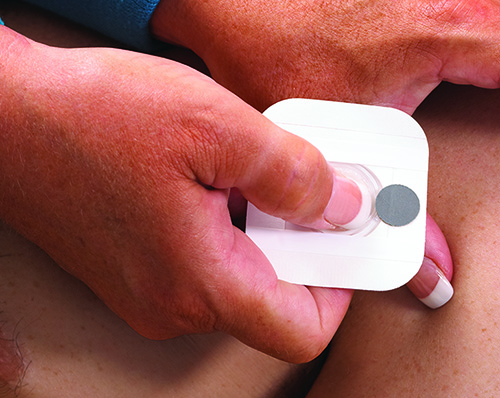Regardless of size, many components are part of a medical device. Yet some designers and engineers still do not involve their component partners early enough in the product development process. We hear it over and over again from component manufacturers that OEMs come to them too late, when they’ve already made the decision on the type of component and the characteristics required, before consulting with their partner.
When developing adhesives for the skin, early involvement of the material partner is critical. The skin has many features that affect how a material will adhere to and wear on its surface. If the wrong adhesive is chosen for an application, skin injury can occur as a result of improper adhesive-to-skin attachment (this includes stripping, tears, blisters, and irritant contact dermatitis), which can lead to infection, delayed healing and other complications. Because skin is a dynamic interface, key questions should be asked before selecting the appropriate adhesive for short, medium and long-term applications, says Diana Eitzman, Ph.D., Director of Agile Commercialization in 3M’s Critical & Chronic Care Solutions Division:
- Where will the device be placed?
- How old is the patient? Neonatal skin is fragile and thin; the elderly also have a thinner epidermis.
- What is the patient’s activity level? (i.e., sweat and prolonged exposure to water can have a big impact)
- Other human factors: What is the patient’s race? Culture? Diet and health? In what environment does the patient live?
- How will the device be sterilized? (i.e., acrylates have many options; silicone cannot be gamma sterilized)

For gentle adhesives used on fragile skin, three days tends to be the maximum wear time, advises Eitzman. For longer-term applications, 14 days is the realistic limit to achieve consistent performance.
Eitzman encourages the use of wear time studies of the final product, as they are the most reliable predictor of performance. “When you are running your studies make sure you are looking at wear time, skin health and multiple factors [see above],” says Eitzman. “Understand that the skin sheds every 14 days, and the surface you’re adhering to is constantly changing. It’s also important to know your patient population to ensure you’re picking the right adhesive for the application.”
3M recently started leveraging its Clinical Research Group to gather data on adhesives and test wearables. The company develops Institutional Review Board approved protocols and uses healthy employee volunteers to screen for wear time performance and skin health, typically conducting 15-day extended wear studies. “It helps device manufacturers select the optimum construction quickly by providing directional input on the wear time performance of 3M’s portfolio of adhesives recommended for wearable device applications,” says Eitzman. Recent studies with experimental adhesive constructions that have been optimized for wear time and which included a rigid, occlusive mock device, showed good clinical results in a recent 15-day study. Since skin is so variable, the criteria for good performance is typically greater than 80% of samples attached, and less than 20% lift along with healthy skin and low pain upon removal of the adhesive.
The primary use for longer-term adhesive applications (7–14 days) includes glucose monitoring and cardiac monitoring. As devices become thinner, more flexible and integrate more sensor capabilities, future applications could include infusion pumps and other applications that deliver medications, more applications that monitor pregnancy and newborn health, remote monitoring and treatment outside the hospital, temperature monitoring, pain monitoring, diagnostics that enable device adherence for treatment, and virtual reality.








